The Boeing Stratocruiser was the largest and most luxurious airliner of its time. Passengers loved it, but it still failed as a commercial transport. Its mainline service career lasted only a decade, thanks to the one-two punch of eye-watering operating costs and the arrival of the more efficient Boeing 707. It didn’t help that the Stratocruisers’ high-tech propellers often tore themselves loose from the engines, leaving the worldwide fleet with a stupefying accident record. Of the 56 Stratocruisers Boeing built, Pan American Airways alone lost seven—almost one a year between 1952 and 1959. United, Northwest Orient and BOAC each crashed one. Surviving Strats ended up being sold for scrapyard prices. But those junked airplanes led to the development of a remarkable new category of aircraft known as volumetric transports—or, more familiarly, Guppies.
Boeing called the Stratocruiser the Model 377, and its lineage led from…well, nits are painstakingly picked over this issue. Many say that the roots of its family tree were fertilized by the B-29 Superfortress, or at least the later B-50 version, which used the R-4360 engines that would power the Stratocruiser. Others point to Boeing’s double-deck C-97 Stratofreighter and its aerial-refueling tanker version, the KC-97. (To Boeing, these two B-50 derivatives were called Model 367s.) Conventional 1940s aeronautical engineering theory held that there was a limit to an airplane’s fuselage diameter relative to wingspan and powerplants, so most aircraft were designed with a small fuselage and large wings. The porcine Douglas C-124 Globemaster II, the first big postwar transport, pushed fuselage diameter to the max that convention would allow. The C-97, however, pushed things even further.
Some Boeing nerds nominate a single modified Model 367 as the Stratocruiser’s daddy. It was a C-97 that had been fitted out as a passenger-carrying VIP transport, with 80 seats and multiple windows on two levels, called the YC-97B and later designated the C-97B. Boeing built only one.
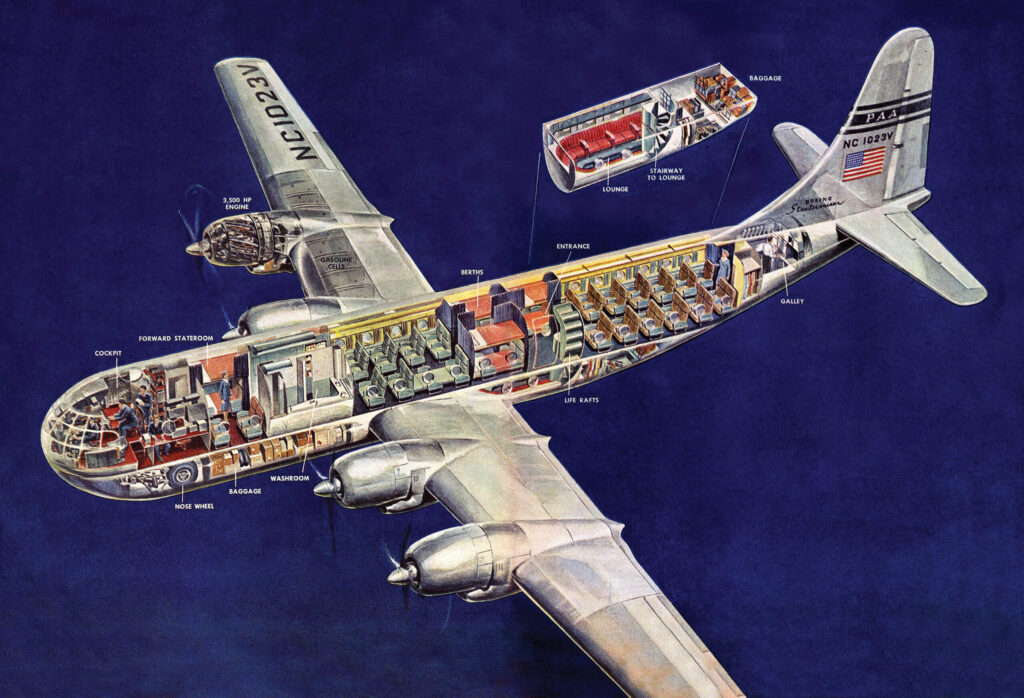
(Pan Am/HistoryNet Archives)
Its mechanical antecedents notwithstanding, the Stratocruiser came into being thanks largely to one man: Pan Am founder and CEO Juan Terry Trippe. Some assumed from Trippe’s first name that he was Latino. Others accused him of adopting the name to make himself attractive to the South American market where Pan Am originally flew. The truth is that Trippe was a whitebread Yalie who had been named after a distant Venezuelan relative, Juanita Terry. After graduating from Yale, Trippe had worked as a Wall Street financier until he decided to enter the aviation business in 1922, first with a company called Long Island Airways and later with a Florida-based company that evolved into Pan American World Airways. In the years leading up to World War II, Trippe made Pan American Airways synonymous with luxury, grace and prestige by operating a fleet of four-engine Boeing and Martin flying boats over Atlantic and Pacific routes, particularly from San Francisco to Hawaii. These airplanes were the most opulent of their time, and they flew for a coterie of wealthy travelers who had survived the Great Depression. After the war, Trippe wanted to lure this clique back to the Pan Am, but the long runways constructed during the war could now support landplanes like the Lockheed Constellation and the Douglas DC-4 and -6, effectively putting the fancy flying boats out of business.
Pan Am had been operating a small fleet of Boeing 307 Stratoliners—a pressurized derivative of the B-17 Flying Fortress—but the “Stratoclipper,” as Pan Am dubbed it, was not a success. It didn’t have the range to either cross the Atlantic or fly nonstop across the U.S. The Constellation blew it away, and the Constellation was being operated by Howard Hughes’ TWA. This infuriated Trippe, who hated Hughes, and it had a lot to do with Trippe’s motivation as the Model 377’s launch customer.
Trippe wanted to offer luxury travel with a new semi-double deck airliner that Boeing president William Allen proposed in 1945 and called the Model 377 Stratocruiser. It had a distinctive stepless, glazed-beachball nose and a 14-seat “downstairs” cocktail lounge, accessed via a tight spiral staircase. (Not until the 747 would there be another such extravagance, though the lounge was upstairs rather than down and was quickly turned into revenue space with rows of first-class seats.) Boeing suggested a high-density, 95-seat version of the 377 to be called the Stratocoach, but Trippe recoiled. He wanted a luxury liner, not a cattle car—an airplane to compete with sumptuous ocean liners.
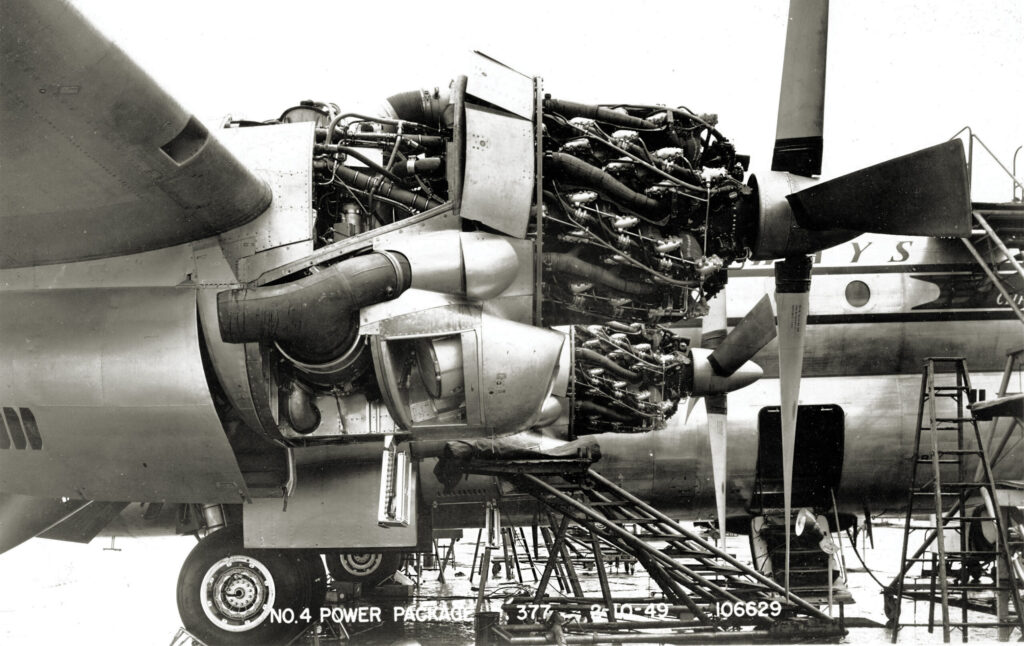
(Chronicle/Alamy)
Trippe ordered 20 Stratocruisers (and later purchased the prototype) with the proviso that Boeing supply none to any airline before Pan Am had at least six. Pan Am paid $1,304,390 each, not including spares, and the airline took delivery of that batch in Oregon instead of Boeing’s home state of Washington, to avoid paying the latter state’s sales tax. At the time, Constellations sold for $1,200,000 and DC-6s went for under a million. After Pan Am, Northwest Orient became the second-biggest Stratocruiser operator by purchasing ten. American Overseas Airlines ordered eight and United bought seven. Swedish Intercontinental Airlines (SILA), soon to become the core of the Scandinavian SAS consortium, bought four, and Britain’s BOAC ordered six to use until the de Havilland Comet jet became operational.
For its Stratocruisers, Pan Am hired the modernist industrial designer Walter Dorwin Teague to lay out the interiors. Teague used muted colors and simple patterns—no busy floral prints, just gentle lines to match the horizon, so passengers wouldn’t be jarred by looking out a window and then back into the cabin. Everything was done to make the cabin seem wider and taller and to avoid designs that might encourage motion sickness.
At Pan Am’s request, Boeing installed air conditioning that could run independently of other aircraft systems, so that passengers who wished to stay asleep in their berths after the Stratocruiser landed could do so in comfort. Some sleeping berths were wide enough for two, encouraging membership in the four-mile-high club, and an aft compartment was even dubbed the Honeymoon Suite, since Hawaii was a popular destination for newlyweds. Unfortunately, it could turn into a rough ride, since the Stratocruiser was prone to porpoising in turbulent conditions.
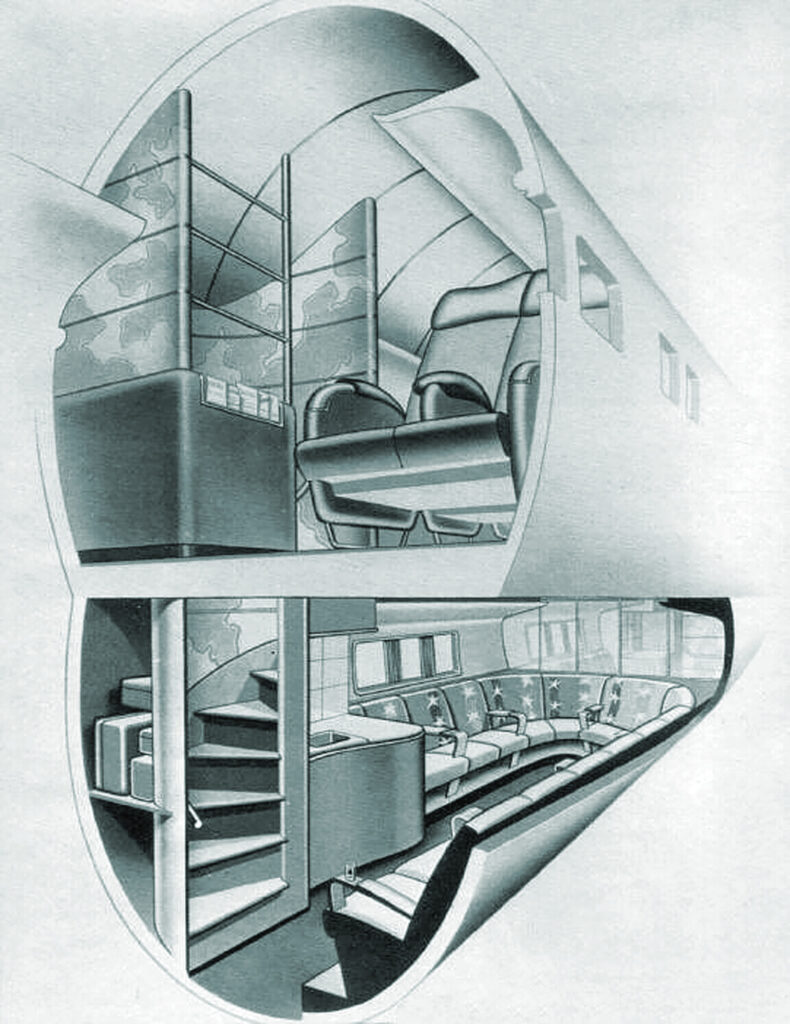
(HistoryNet Archives)
The Stratocruiser was originally intended to have four 2,200-hp Wright R-3350 engines—the B-29’s powerplant—but it was Trippe who suggested using the R-4360s that had been developed for the B-50. They were the most advanced and powerful piston radials to go into production, but Trippe would come to regret his choice. It quickly became apparent that the bleeding-edge technology of the R-4360 and its huge four-blade propeller was not synonymous with reliability or safety. The Pratt & Whitney Corncobs (so named because their 28 cylinder heads resembled rows of kernels) were remarkable engines, putting out 3,500 water-injected horsepower on takeoff, but they pushed the materials and technology of the time beyond reasonable limits. They were a-bridge-too-far engines. Hawaii passengers on 377s would later routinely boast that they’d made it to Honolulu on three engines, occasionally two.
Boeing claimed that the 80-seat 377 would provide luxury, speed and range for just a penny per passenger mile, though this was almost certainly before the true specific fuel consumption of the R-4360 became apparent. Although R-4360s powered all of the super-large postwar airlifters—C-97, C-124 and XC-99—the engine had poor fuel specifics. It burned .43 gallons of gasoline per hour per horsepower while the ubiquitous Pratt & Whitney R-2800 used .38. DC-6s powered by R-2800s soldiered on well after the Stratocruiser was put out to pasture.
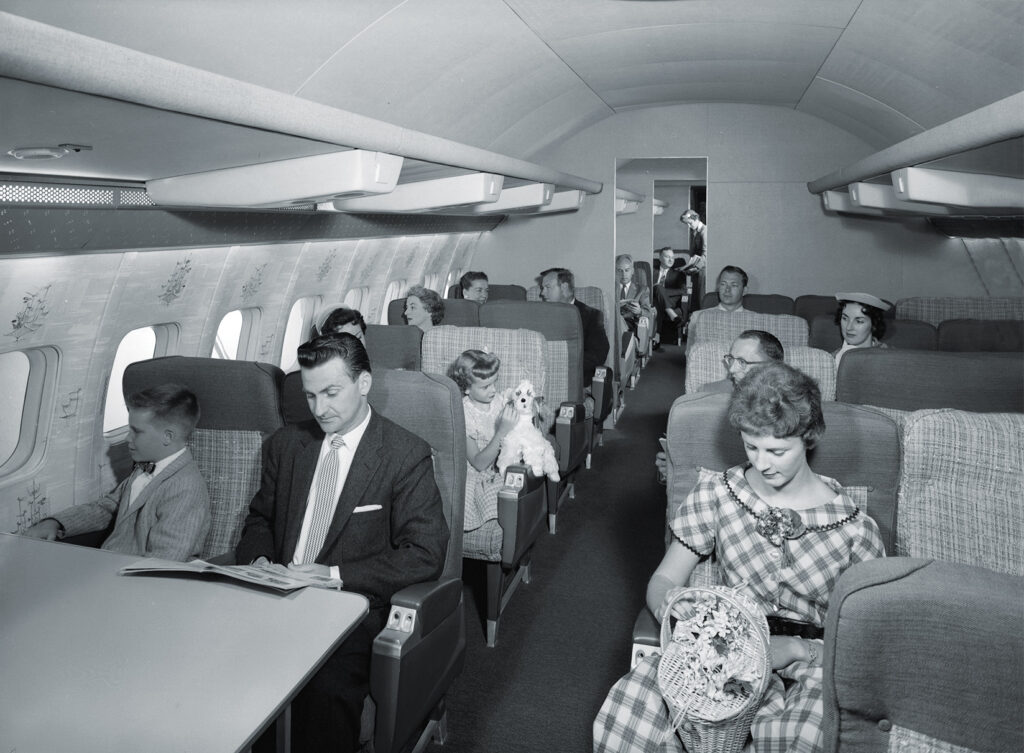
(Michael Ochs Archive/Getty Images)
The Strat was the first airliner with turbochargers, though they weren’t used to provide takeoff power. The advanced General Electric turbos joined the chorus during climb and cruise, to turbo-normalize the engines’ rated power. In fact, they doubled the R-4360’s output at altitude, which allowed it to cruise at over 300 mph at 25,000 feet. (Top speed was 340 mph.) The Stratocruiser was also the first American commercial aircraft to employ water injection, which boosted takeoff power from 3,000 to 3,500 horsepower. And it was the first airliner to use the more efficient underwing pressure fueling instead of above-wing gravity-fed fueling, but it still took about two and a half hours to top up the airplane’s standard 7,790-gallon nylon wing bladders. (Pan Am added capacity for an additional 360 gallons to 10 of its Strats, so they could make the New York-to-London trip nonstop. They called them Super Stratocruisers.) Northwest Orient claims to have used its Stratocruisers to become the first airline to serve liquor in U.S. airspace, in August 1959.
At one point Trippe asked Boeing to engineer a six-engine version of the Model 377. He wanted two Wright R-1820s outboard of the number-one and -four R-4360s. It’s not clear why Pan Am dreamed up this impractical mix. Perhaps because it knew how prone to failure the Pratts were? Or was Trippe simply fond of the classy six-engine airliner concept? He was, after all, the only airline executive to express interest in a commercial version of the six-engine Convair B-36 bomber. Convair had proposed an airliner version of its XC-99, essentially a double-deck B-36, which Trippe saw as a 400-passenger leviathan that could support transcontinental ticket prices equivalent to bus fare. But feeding six ravenous R-4360s exceeded what any airline could afford.
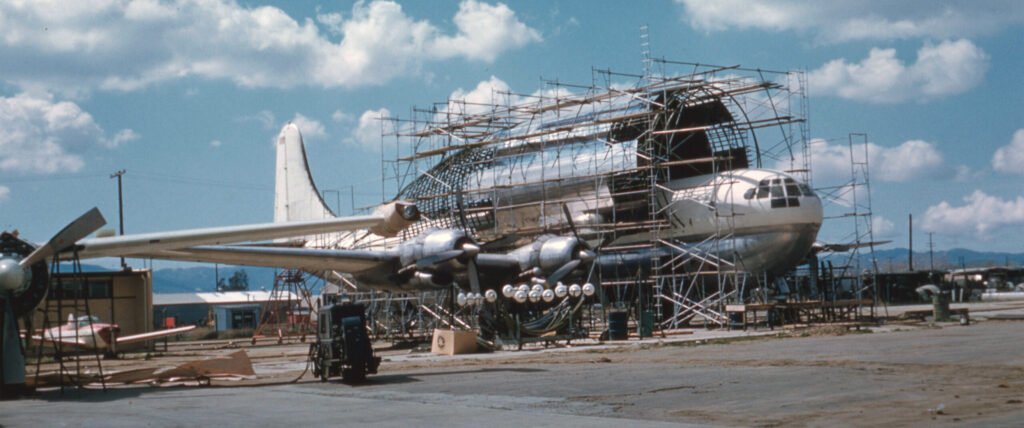
(Chronicle/Alamy)
One of the secrets of the 377’s speed and range was the famous high-aspect-ratio “Boeing wing,” with its proprietary 117 airfoil. Originally designed for the B-29, it was particularly light yet efficient. The Model 377’s wing was 16 percent stronger, 650 pounds lighter and 26 percent more efficient than the original B-29 wing.
Stratocruisers began coming apart within nine months of entering service. In January 1950 a Pan Am Strat dropped an engine into the Pacific en route to Tokyo. A day later, a Northwest Orient 377 had the number-one engine separate from the wing near Chicago. Pan Am suffered its first 377 passenger fatalities in April 1952, when a prop blade separated from the number-two engine over Brazil and the airplane shook itself to death, the pieces falling into the Amazon jungle. The wreckage was finally spotted three days later, but there were no survivors among the 50 passengers and crew. Nor was the number-two engine and prop ever found.
Investigators were initially baffled by the crashes, but it soon became apparent that the props were the airplane’s Achilles’ heel. Some Stratocruisers had Curtiss electric propellers, usually looked upon warily because of electric-gremlin-induced overspeeds and sudden in-flight prop reversals, but the Curtisses proved docile on the Stratocruiser. However, the typically reliable hydromatic Hamilton-Standard airscrews were not. That’s because the propeller company had lightened the big steel blades for the Stratocruiser by hollowing them and filling the voids with rubbery neoprene. The filler, glued in place, would break loose and quickly stuff itself into the outer extremity of the hollow space, flung outward by the prop’s rotation. The sudden imbalance would cause the prop tip and even the entire blade to break loose. The hollow blades were also prone to cracking or simply breaking.
The most notorious Stratocruiser accident occurred in October 1956, when a Pan Am Strat flying between Honolulu and San Francisco, on the last leg of a round-the-world trip, had a runaway number-one prop that the crew was unable to stop or feather. They oil-starved the engine, which seized, but the prop continued to windmill. The drag was massive. And then the number-four engine decided to ignore its throttle.
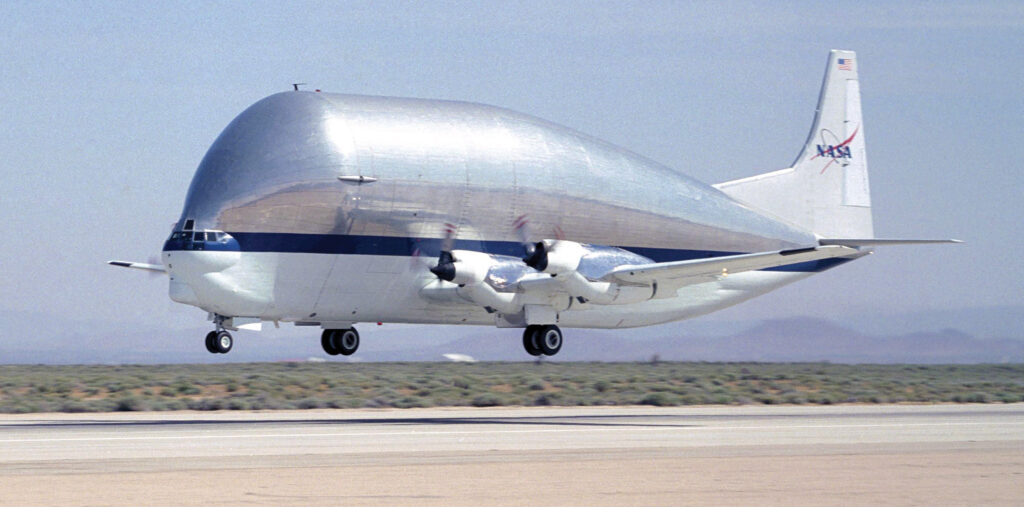
(NASA/Tony Landis)
Barely aloft on two good engines in the middle of the night, the crew headed for the Coast Guard cutter Pontchartrain, which was on ocean-station duty just 40 miles away. The airplane orbited the cutter until daylight, and then the crew skillfully ditched alongside the ship. All 24 passengers and crew were rescued. Not until pilot Chesley Sullenberger and first officer Jeff Skiles ditched their Airbus in the Hudson River in January 2009 was a water landing so celebrated, or so fully documented.
On November 8, 1957, another Pan Am Stratocruiser plunged into the Pacific somewhere between Hawaii and San Francisco. Thirty-eight passengers and six crew were lost, and the cause of the accident remains a mystery. Both the FBI and Pan Am were convinced that foul play was involved. Conspiracy theories revolved around the fact that there were a number of important French businessmen aboard, including a vice-president of automaker Renault, as well as a U.S. Air Force major supposedly involved in a clandestine operation of some sort and a former Navy frogman and demolition expert. Nor did it help that the flight’s purser was known to be an unhappy employee who owned a handful of blasting-cap detonators.
In late 1958, 12 years after the 377 had first flown, the Civil Aeronautics Board finally issued an airworthiness directive requiring the removal of its hollow-core props. By that time, disintegrating props had resulted in the loss of a quarter of Pan Am’s Stratocruiser fleet, but federal bureaucracy ensured that the airplane’s propeller problems were dealt with somewhere between slowly and not at all.
The 56 Stratocruisers that Boeing built, including the prototype, were just a small portion of the 888 Model 367s and 377s Boeing manufactured, the vast majority of them C-97s and KC-97s. But the Stratocruiser was the airplane that established Boeing as an airliner builder. (The Model 314 Clipper flying boat was a small-run specialty airplane—just 12 built—not a mainline airliner.) But by the late 1950s, their luxury cachet meant little when the real jet set had turned to the 707. Low-cost airlines still flying props were looking for airplanes that were cheap to fly, not Stratocruisers. Transocean, an off-brand carrier that had amassed a fleet of 14 Stratocruisers, sold them all for $7,500 apiece—well less than the cost of a new Aston Martin DB-4 sports car.
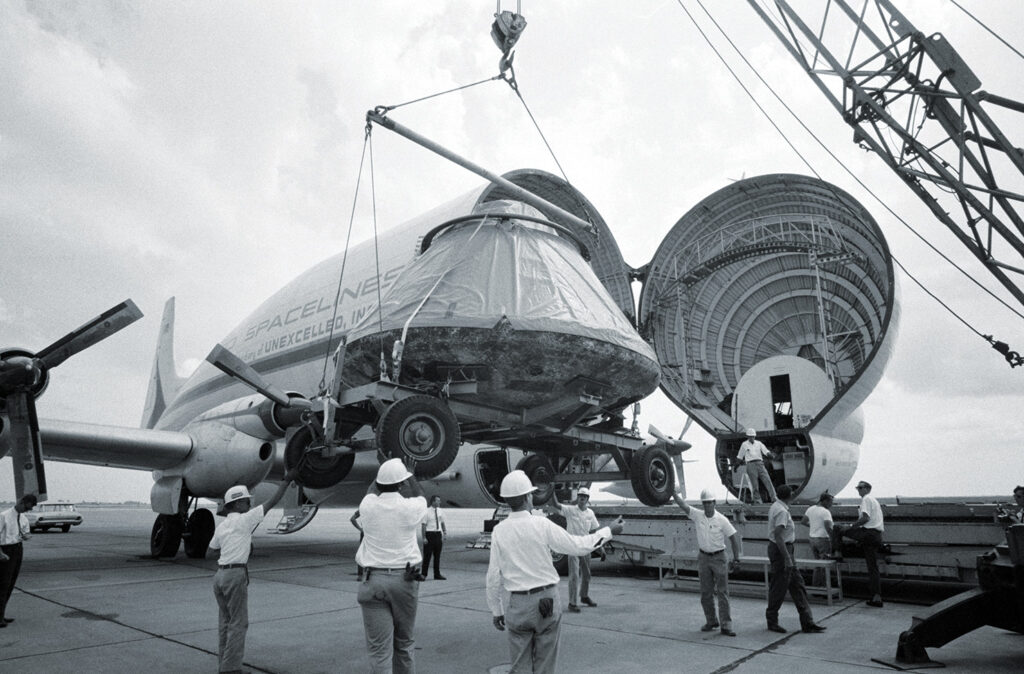
(NASA)
The Stratocruiser’s rebirth as a family of super-sized Guppies was initially the work of two men: Jack Conroy and Leo Mansdorf. Conroy was a former B-17 pilot who had become a POW after being shot down over Germany. After the war he was an airline captain, California Air Guard weekend warrior and coast-to-coast record setter in an F-86A Sabre. Mansdorf was an obscure aircraft broker. Yet Mansdorf had bought up almost the entire surviving Stratocruiser fleet at literally a dime on the dollar. He had no idea what to do with them, but he couldn’t resist the bargain.
Mansdorf initially had the idea of grossly inflating Stratocruiser fuselages so they could transport rocket components for NASA. The space agency had been shipping rockets by barge from Texas to Florida’s Cape Canaveral, and the voyage took 25 days, with sea-air corrosion always a problem. Transport by air would cut shipping time to 18 hours, including loading and unloading, and every hour counted during the space race. For his part, Conroy had wanted the airplanes to start a California-to-Hawaii VIP airline, but he bought into Mansdorf’s concept after a well-lubricated lunch with Mansdorf and a bunch of airplane buddies who tossed around preposterous suggestions of what they could build to snare a NASA contract.
NASA didn’t have the budget to develop the needed heavy lifter itself, and it would have been wildly expensive for Boeing, Douglas or Lockheed to design and engineer such a limited-use craft. Conroy, however, decided to develop a volumetric transport from surplus aircraft—Mansdorf’s Stratocruisers—using private funds from speculators. Conroy himself poured almost a million dollars into the project, under the company name of Aero Spacelines, Inc.
It was an enormous leap of faith. No established aeronautical engineer would buy into the concept of trying to fly an airplane with so extreme a fuselage diameter. But Conroy took the design beyond those assumed limitations. It was hard to imagine anybody developing a successful cargo carrier from the husks of so unsuccessful an airliner. And husks they were, for intact Stratocruisers weren’t used to build Guppies; instead, mix-and-match major components—cockpit sections, empennages, fuselages, wings—were patched together. Many of them were from C-97s, not Strats.
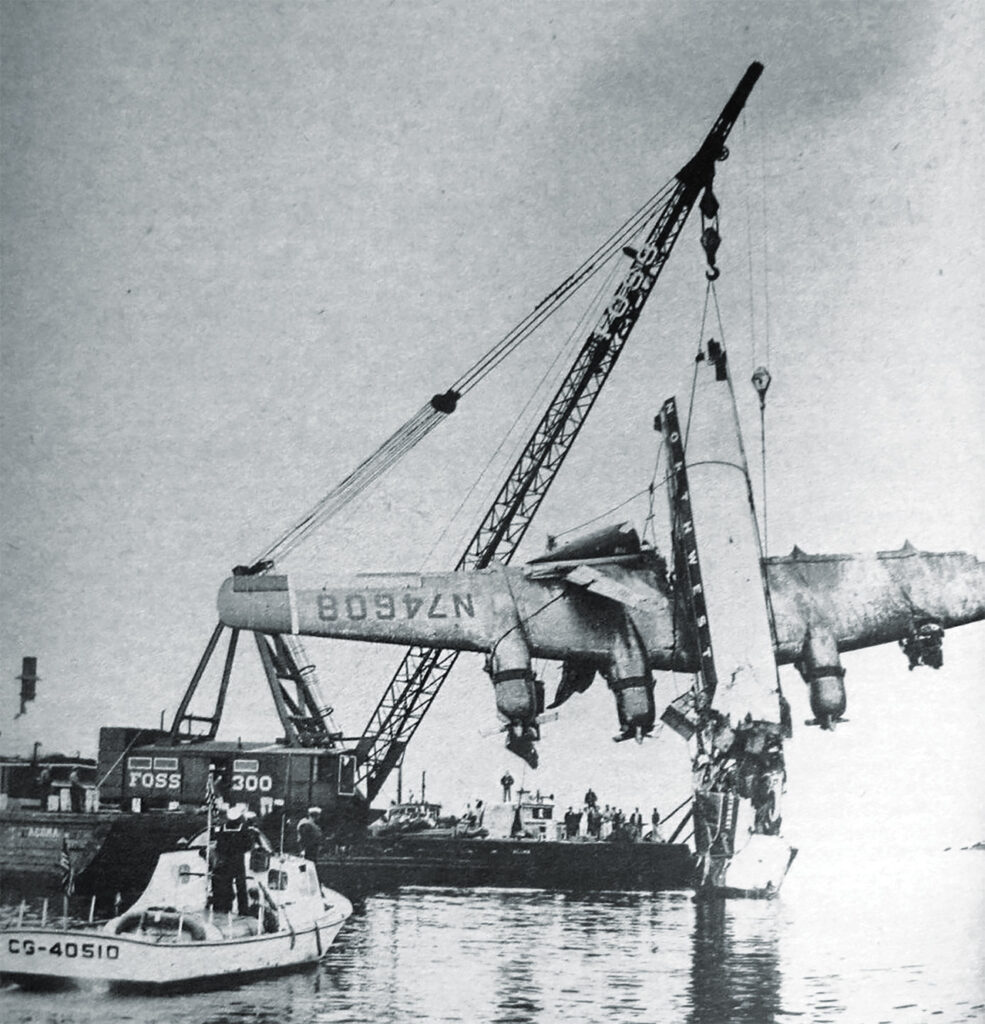
(Rapp Halour/Alamy)
German rocketeer Wernher von Braun, who had become the director of NASA’s Marshall Space Flight Center in Huntsville, Alabama, in 1960, had been a pilot since the mid-1930s and had flown everything from Messerschmitt Me-109s to helicopters. He involved himself substantially in the Guppy program. The initial idea had been to carry rocket loads externally, atop Douglas C-133s, but von Braun quickly nixed that scheme. He was also a big help when the Federal Aviation Administration became antsy about granting Conroy’s monsters the supplemental type certificate required for a modified aircraft. Von Braun leaned on the FAA to get with the program.
The first of the bloated Stratocruisers was called the Pregnant Guppy and in 1963 it transported components of the Titan rocket used for the Gemini program and went on to fly parts of Apollo’s Saturn. The Super Guppy, next in line, replaced the PG’s R-4350 engines with either Pratt & Whitney or Allison turboprops (five were built). The Mini Guppy reverted to R-4360s and was built to carry conventional oversize commercial cargo. It was the only version to be fully FAA-certificated.
And here the Stratocruiser line dies out, with just one Super Guppy still being operated by NASA. Not a single Stratocruiser survives, not even as a static museum exhibit. The jets arrived just in time. Had anybody tried to push the Stratocruiser’s 1930s technology just one level further, it would have been a disaster.


